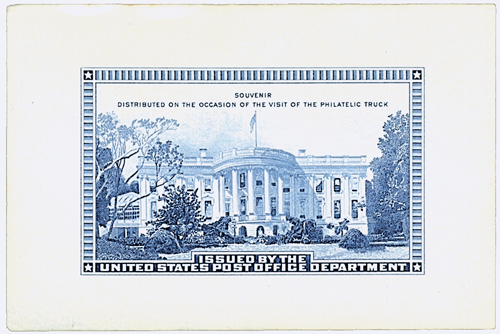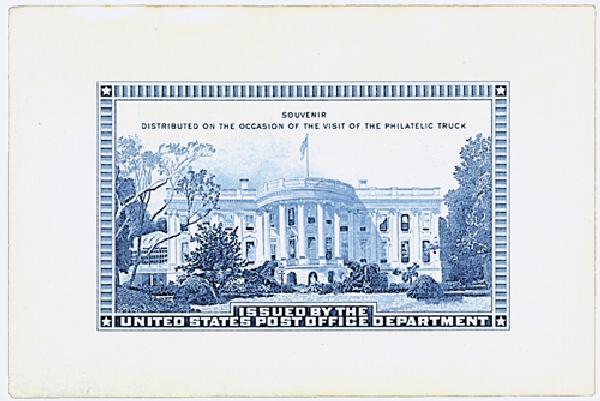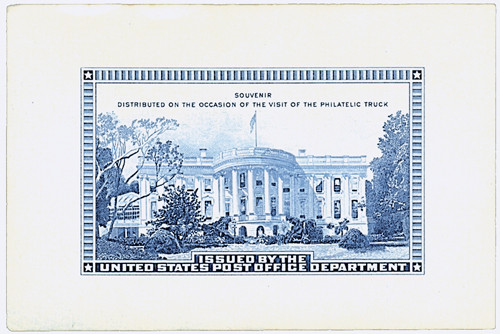
# M395a - 1939 Philatelic Truck Souvenir Sheet, without Gum and with Small Imperfections
Limited-Edition Philatelic Truck Souvenir Card
Stamp-collecting President Franklin Roosevelt ordered the creation of a traveling exhibit in the 1930s to show Americans how stamps were made. Housed in a "Philatelic Truck," the exhibit crossed the country, stopping at hundreds of places and handing out special souvenir cards. These cards, depicting the White House, were actually printed aboard the truck! As visitors exited the truck, they were given one of these White House cards as a souvenir – hence the name. Own yours in unused condition (one or two small flaws that don't detract from beauty or collectibility) today.
Philatelic Truck Begins Its Journey
On May 9, 1939, the Philatelic Truck departed the White House on a cross-country journey to introduce thousands of Americans to the exciting world of stamps.
The Philatelic Truck was the brainchild of stamp-collector President Franklin Roosevelt. He ordered the traveling exhibit to show Americans how stamps were made. The first public mention of the truck was in an August 1938 article in The New York Sun that stated the truck’s purpose was to “stimulate interest in stamp collecting among the youth of the country.”
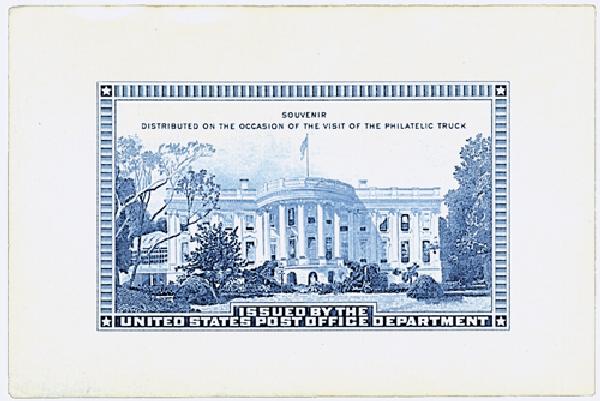
The truck was a custom-made armored vehicle that served as a mobile philatelic museum. It carried specimens of every US stamp issued from the 1847 Franklin and Washington issues to those issued at the time of the tour. The tour officially began on May 9, 1939, with a special ceremony at the White House. After that, Postmaster General James A. Farley performed his final inspection of the truck before it set out on its journey.
Over the next 28 months, the truck traveled the nation stopping at hundreds of schools, libraries, and other sites. Visitors to the truck got to see dies and plates used to make stamps as well as a set of die proofs. In the center of the truck was a miniature Stickney printing press. The press simulated the printing of souvenir sheets that were slowly rolled out and cut for each visitor to take home. In reality, these sheets had been pre-printed by the Bureau of Engraving and Printing in large rolls. Over time though, the truck’s operators found that the press moved too slowly to efficiently hand out the souvenir sheets to the large crowds, so they began handing out pre-cut cards.
Additionally, the cards handed out during the first year were gummed. But soon, people began finding the sheets stuck to windows, cars, and even the truck itself, they began producing the sheets ungummed. The gummed cards are much harder to find today than the ungummed. Young visitors also had the opportunity to purchase a book produced specifically for the tour for 10¢ – A Description of United States Postage Stamps – Junior Edition.
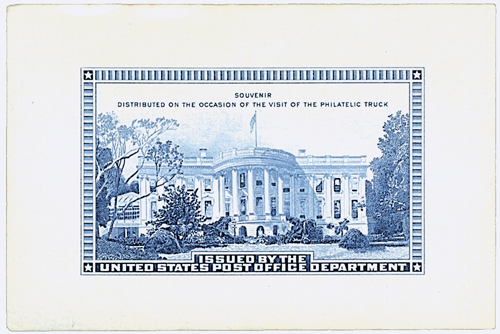
Visitors to the truck also had the option to mail out letters right there. If they wanted, they could use special envelopes produced specially for the Philatelic Truck. The truck also made a special stop in 1940, at the 46th Annual Convention of the Society of Philatelic Americans. People who visited the truck at this convention received a scarce variety with an overprint marking the convention, which you can view here.
On an average day, about 800 people would usually get to visit the truck. Reportedly, the largest visitation occurred in Pittsburgh, Pennsylvania, on Labor Day. The truck was parked at the city’s fairgrounds and was visited by about 5,000 people.
After more than two years of traveling, the philatelic truck’s journey was cut short by the Japanese attack on Pearl Harbor on December 7, 1941. The truck was rushed from Yuma, Arizona, to its final stop in San Diego, California, on December 12, 1941. There, the exhibits were removed and sent back to Washington, D.C. The truck itself was reportedly left at the Rincon Annex of the San Francisco Post Office. During its trip, the truck had traveled 20,750 miles, visited 490 towns, and had 483,976 visitors.
Click here to see a photo of the truck on the first day of its journey.
Limited-Edition Philatelic Truck Souvenir Card
Stamp-collecting President Franklin Roosevelt ordered the creation of a traveling exhibit in the 1930s to show Americans how stamps were made. Housed in a "Philatelic Truck," the exhibit crossed the country, stopping at hundreds of places and handing out special souvenir cards. These cards, depicting the White House, were actually printed aboard the truck! As visitors exited the truck, they were given one of these White House cards as a souvenir – hence the name. Own yours in unused condition (one or two small flaws that don't detract from beauty or collectibility) today.
Philatelic Truck Begins Its Journey
On May 9, 1939, the Philatelic Truck departed the White House on a cross-country journey to introduce thousands of Americans to the exciting world of stamps.
The Philatelic Truck was the brainchild of stamp-collector President Franklin Roosevelt. He ordered the traveling exhibit to show Americans how stamps were made. The first public mention of the truck was in an August 1938 article in The New York Sun that stated the truck’s purpose was to “stimulate interest in stamp collecting among the youth of the country.”

The truck was a custom-made armored vehicle that served as a mobile philatelic museum. It carried specimens of every US stamp issued from the 1847 Franklin and Washington issues to those issued at the time of the tour. The tour officially began on May 9, 1939, with a special ceremony at the White House. After that, Postmaster General James A. Farley performed his final inspection of the truck before it set out on its journey.
Over the next 28 months, the truck traveled the nation stopping at hundreds of schools, libraries, and other sites. Visitors to the truck got to see dies and plates used to make stamps as well as a set of die proofs. In the center of the truck was a miniature Stickney printing press. The press simulated the printing of souvenir sheets that were slowly rolled out and cut for each visitor to take home. In reality, these sheets had been pre-printed by the Bureau of Engraving and Printing in large rolls. Over time though, the truck’s operators found that the press moved too slowly to efficiently hand out the souvenir sheets to the large crowds, so they began handing out pre-cut cards.
Additionally, the cards handed out during the first year were gummed. But soon, people began finding the sheets stuck to windows, cars, and even the truck itself, they began producing the sheets ungummed. The gummed cards are much harder to find today than the ungummed. Young visitors also had the opportunity to purchase a book produced specifically for the tour for 10¢ – A Description of United States Postage Stamps – Junior Edition.

Visitors to the truck also had the option to mail out letters right there. If they wanted, they could use special envelopes produced specially for the Philatelic Truck. The truck also made a special stop in 1940, at the 46th Annual Convention of the Society of Philatelic Americans. People who visited the truck at this convention received a scarce variety with an overprint marking the convention, which you can view here.
On an average day, about 800 people would usually get to visit the truck. Reportedly, the largest visitation occurred in Pittsburgh, Pennsylvania, on Labor Day. The truck was parked at the city’s fairgrounds and was visited by about 5,000 people.
After more than two years of traveling, the philatelic truck’s journey was cut short by the Japanese attack on Pearl Harbor on December 7, 1941. The truck was rushed from Yuma, Arizona, to its final stop in San Diego, California, on December 12, 1941. There, the exhibits were removed and sent back to Washington, D.C. The truck itself was reportedly left at the Rincon Annex of the San Francisco Post Office. During its trip, the truck had traveled 20,750 miles, visited 490 towns, and had 483,976 visitors.
Click here to see a photo of the truck on the first day of its journey.




